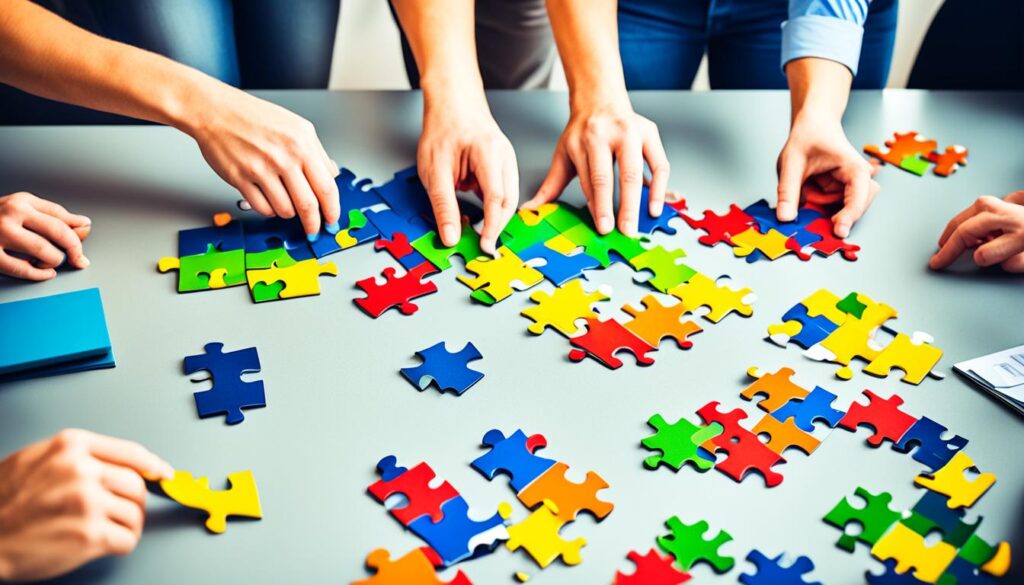Imagine a team where everyone is on the same page, working together seamlessly towards a common goal. Communication flows effortlessly, ideas are valued, and collaboration is constructive. In this team, efficiency soars, and workplace success becomes the norm.
Now imagine another team, where communication is strained, conflicts arise frequently, and individual contributions go unnoticed. This team struggles to achieve desired outcomes, and workplace efficiency suffers as a result.
The difference between these two scenarios lies in the understanding and management of team dynamics. Effective team dynamics are crucial for achieving organizational goals and desired outcomes in the workplace. When team members understand their interactions, relationships, and communication patterns, they can harness their collective strengths and overcome challenges.
Building and maintaining effective team dynamics can be challenging, but it can provide a competitive advantage for organizations. By mastering the art of team dynamics feedback, leaders can create an environment where employees thrive and workplace efficiency thrives. Let’s explore how we can unlock the power of team dynamics for workplace success.
Key Takeaways:
- Understanding team dynamics is crucial for workplace efficiency and success.
- Effective team dynamics involve interactions, relationships, and communication patterns among team members.
- Factors such as team size, diversity, and leadership style influence team dynamics.
- Fostering positive team dynamics requires clear goals, open communication, trust, diversity, and team-building activities.
- Mastering team dynamics feedback is key to unlocking the full potential of a team.
Defining Team Dynamics
Team dynamics encompass the interactions, relationships, and communication patterns among team members. It involves how individuals work together to achieve a common goal, make decisions, and solve problems.
Effective team dynamics require collaboration, trust, open communication, and a clear understanding of individual roles and responsibilities. When team members work together effectively, they can leverage their unique skills and perspectives to approach problems from multiple angles.
On the other hand, poor team dynamics can lead to conflict, misunderstandings, and a lack of progress. It is essential for team members to establish a foundation of trust and open communication to foster healthy and productive team dynamics.
In order to illustrate the importance of team dynamics, consider the following quote:
“A successful team is not just about combining individual talents; it is about creating an environment where the whole becomes greater than the sum of its parts.”
By embracing effective team dynamics, teams can achieve higher levels of collaboration, creativity, and innovation. A study conducted by Harvard Business Review found that teams with strong dynamics outperformed their peers by 17% in terms of revenue and 20% in terms of customer satisfaction.
Now, let’s take a closer look at the factors that influence team dynamics in the next section.
Factors Influencing Team Dynamics
Several factors can greatly influence the dynamics within a team. Understanding these factors is crucial for fostering effective collaboration and achieving desired outcomes. The size of a team is one such aspect that significantly impacts team dynamics. Larger teams may face challenges in effectively communicating and coordinating tasks, leading to potential inefficiencies. On the other hand, smaller teams may struggle with tasks that require a broader range of skills. It is important for team leaders to consider the optimal team size to ensure smooth workflow and task allocation.
Diversity within a team also plays a vital role in shaping team dynamics. While diversity can present challenges in terms of different perspectives and approaches, it also offers a broader range of ideas and insights. A diverse team brings together individuals with varied experiences, backgrounds, and expertise, which can lead to more innovative solutions and enhanced creativity. However, effective communication and collaboration practices must be in place to ensure that diverse ideas are valued and conflicts are handled constructively.
Another significant factor that influences team dynamics is the leadership style adopted by those in charge. The leadership style can either contribute to a positive work environment or create unnecessary tension and negativity. Micromanaging leaders tend to stifle team autonomy and hinder the development of trust and collaboration. In contrast, empowering leaders foster teamwork, open communication, and provide support to team members. An empowering leadership style enhances team dynamics by encouraging individual growth, autonomy, and participation in decision-making processes.
External factors, such as market trends and competition, also have an impact on team dynamics. Organizations operating in competitive industries may experience added pressure and stress, which can affect team dynamics and productivity levels. It is essential for team leaders to address external challenges effectively, promote teamwork and collaboration, and provide the necessary support to mitigate any negative impact. By acknowledging and adapting to these external factors, teams can maintain a cohesive and productive work environment despite external pressures.

To summarize, team dynamics are influenced by various factors, including team size, diversity, leadership style, and external factors. By understanding and considering these influences, organizations can create an environment that fosters effective collaboration, enhances productivity, and achieves desired outcomes. Moreover, it is essential for organizations to conduct a master team dynamics assessment to identify strengths and areas for improvement within their teams. This thorough evaluation enables leaders to tailor strategies that promote inclusivity and address any potential conflicts. Ultimately, by prioritizing team dynamics assessment, organizations can cultivate a culture of collaboration and innovation, leading to sustained success in their projects.
Best Practices for Fostering Positive Team Dynamics
Creating a strong and cohesive team requires the implementation of various best practices. By incorporating these strategies, organizations can cultivate positive team dynamics that foster collaboration, innovation, and productivity.
1. Establish Clear Goals and Expectations
Clear goals and expectations provide team members with a sense of purpose and direction. By outlining specific objectives, milestones, and deadlines, individuals can stay motivated and focused on their tasks. This clarity also enables effective communication and facilitates the alignment of individual efforts with overarching team goals.
2. Promote Open Communication and Trust
Open communication is fundamental to building trust and strengthening team dynamics. Encourage team members to share their thoughts, ideas, and concerns openly, fostering a culture of transparency and collaboration. Actively listen to each other’s perspectives, provide constructive feedback, and create an environment where everyone feels comfortable expressing themselves.
3. Embrace Diversity
A diverse team brings a wide range of perspectives, experiences, and skills to the table. By embracing diversity in all its forms, including but not limited to gender, ethnicity, age, and background, organizations can harness the power of different viewpoints to drive creativity and innovation. This inclusive approach helps prevent groupthink and fosters a positive work environment that values and respects everyone’s unique contributions.
4. Encourage Team Building Activities
Team building activities play a vital role in strengthening relationships and enhancing team dynamics. These activities can range from problem-solving challenges to trust-building exercises. By participating in such activities, team members can develop a deeper understanding of each other’s strengths, weaknesses, and communication styles. This shared experience promotes collaboration, trust, and respect among team members.
5. Conduct Regular Team Meetings and Training
Regular team meetings provide a platform for open discussions, updates, and collaboration. They allow team members to address challenges, celebrate successes, and share valuable insights. Additionally, training programs focused on effective communication, conflict resolution, and problem-solving can further enhance team dynamics. By equipping team members with the necessary skills and knowledge, organizations can create a cohesive and high-performing team.

Implementing these best practices can transform a group of individuals into a synergistic and productive team. By setting clear goals, fostering open communication and trust, embracing diversity, promoting team building activities, and investing in regular meetings and training, organizations can create an environment where positive team dynamics flourish.
Conclusion
Team dynamics are a critical factor in achieving workplace success. By understanding and effectively managing team dynamics, organizations can enhance workplace efficiency, productivity, and employee satisfaction. Prioritizing the development of positive team dynamics through clear goals, open communication, trust, diversity, and team-building activities is essential.
Creating a culture of constructive collaboration, where team members receive the necessary support and feedback, enables teams to thrive and reach their full potential. Mastering team dynamics feedback is key to unlocking the full potential of a team. Organizations that focus on fostering positive team dynamics are more likely to achieve their desired outcomes and maintain a competitive edge.
It is evident that effective collaboration and effective team dynamics go hand in hand. By promoting a cooperative work environment and leveraging the unique skills and perspectives of team members, organizations can propel themselves towards success. Investing in team dynamics development is an investment in the overall success and growth of the organization.
FAQ
What are team dynamics and why are they important?
Team dynamics encompass the interactions, relationships, and communication patterns among team members. They are important because they determine how individuals work together to achieve common goals, make decisions, and solve problems. Effective team dynamics can enhance workplace efficiency and productivity, leading to workplace success.
What factors can influence team dynamics?
Several factors can influence team dynamics, including team size, diversity, leadership style, and external factors such as market trends and competition. Team size affects effective communication, diversity brings in varied ideas and perspectives, and leadership style can impact the work environment. Additionally, external factors can increase stress and tension, impacting how team members interact with each other.
How can positive team dynamics be fostered?
Positive team dynamics can be fostered by implementing best practices such as establishing clear goals and expectations, promoting open communication and trust, encouraging diversity within the team, organizing team-building activities, and providing training on effective communication and conflict resolution. These practices facilitate collaboration, creativity, and a positive work environment.
How do team dynamics contribute to workplace success?
Understanding and effectively managing team dynamics can enhance workplace efficiency, productivity, and employee satisfaction. Positive team dynamics foster effective collaboration, open communication, and constructive feedback, allowing teams to thrive and achieve their full potential. This ultimately contributes to achieving organizational goals and desired outcomes.


